One of the most iconic airliners to have graced our skies is the Vickers VC10, a long-range airliner of the 1960s which had four rear-mounted engines and a high T-tail.
Origins of the VC10

The first VC10 to be built, G-ARTA, seen operating for British United Airways (Ken Fielding, distributed under a CC BY-SA 3.0 licence)
The VC10 began life as the Vickers V.1000, designed and developed in response to an Air Ministry Operational Requirement for a new long-range jet transport aircraft for the RAF issued in 1952. An order for a single prototype was placed, followed by a contract for a further six V.1000 aircraft. At the time, BOAC had expressed some interest in a civilian variant designated the Vickers VC7 and had worked with Vickers to refine their proposals.
For political reasons the V.1000 prototype was cancelled in November 1955. This was followed by BOAC withdrawing any further interest in the VC7 project, after deciding to use de Havilland Comet 4s and Bristol Britannias on its major routes. However, less than a year later the Government gave BOAC approval to purchase the Boeing 707 for use on its trans-Atlantic routes as a replacement for the Comet 4. It is believed that this was approved on condition that all additional orders would have to be for British-built aircraft.
In March 1957 BOAC issued a requirement for a high performance, long-range jet airliner to operate on its African and Asian routes which often involved flying into challenging airports with hot and high altitude conditions and short runways. In response, Vickers began to design the VC10. Its characteristics included four rear-mounted Rolls Royce Conway engines, a T-shaped tailplane and a large, high lift wing. The wing, not being cluttered with engines and associated mountings, benefited from the inclusion of leading-edge slats and trailing-edge flaps. These would improve the aircraft’s low speed flying characteristics making it capable of lower approach and take-off speeds and allowing it to operate into both large and small airfields. Although there was a mixed response in BOAC to the Vickers design, BOAC placed an order for 35 139-seat VC10s with an option for a further 20 in January 1958.
Several years before the maiden flight of the first VC10 prototype, BOAC had started discussions with Vickers for a stretched version of the VC10, to accommodate more seating and thus reduce the seat/mile costs, so as to be a more competitive option for its North Atlantic routes. Initially a 212-seat, Super 200 version was proposed, achieved by a fuselage stretch of 28ft, and it included significantly uprated Conway engines. In June 1960 BOAC converted its 20 options for Standard VC10s into an order for 10 of these Super 200 VC10s.
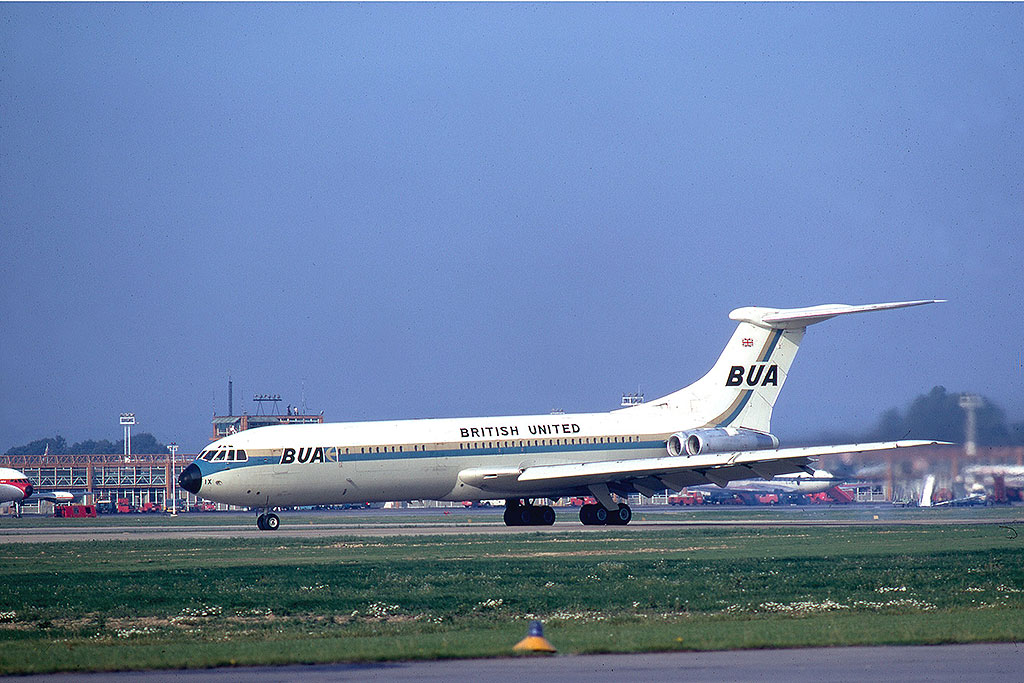
VC10 G-ASIX of British United Airways (clipperarctic, distributed under a CC BY-SA 2.0 Licence)
Subsequently BOAC began to have doubts about the versatility of Super 200 and whether it could fill all 212 seats. The design was revised to include a 13ft fuselage stretch, providing seating for a more modest 174 passengers. This became the Super VC10. The original design was retrospectively known as the Standard VC10. BOAC also had concerns about the potential operating costs of the Standard VC10 compared with the Super VC10. As a result, in 1961, it reduced its order to just 15 Standard VC10s, concomitantly increasing the Super VC10 order to 30 aircraft. The order for Standard VC10s was further reduced to 12 aircraft in January 1962, with the 30 Super VC10s to include 8 aircraft in a passenger/freight (‘Combi’) combination.
In 1964, BOAC attempted to cancel the entire order for 30 Super VC10s, instead intending to purchase Boeing 707s which it considered were cheaper to operate. The Government intervened and BOAC accepted a revised order of 12 Standard VC10s and 17 Super VC10s instead of the original order of 30. The passenger/freight ‘Combi’ version was cancelled.
The prototype Standard VC10 G-ARTA was rolled out at Brooklands Airfield, Weybridge on the 15th April 1962, painted in BOAC livery. Extensive ground testing took place before the maiden flight on the 29 June 1962. The flight test programme was subsequently supported by four production aircraft destined for BOAC. BOAC received its first Standard VC10 (G-ARVI) on the 22 April 1964, and revenue services began seven days later. The final Standard VC10 for BOAC was delivered in February 1965.

Standard VC10 G-ARVF of BOAC at London Heathrow (Ken Fielding, distributed under a CC BY-SA 3.0 licence)
Operational Life
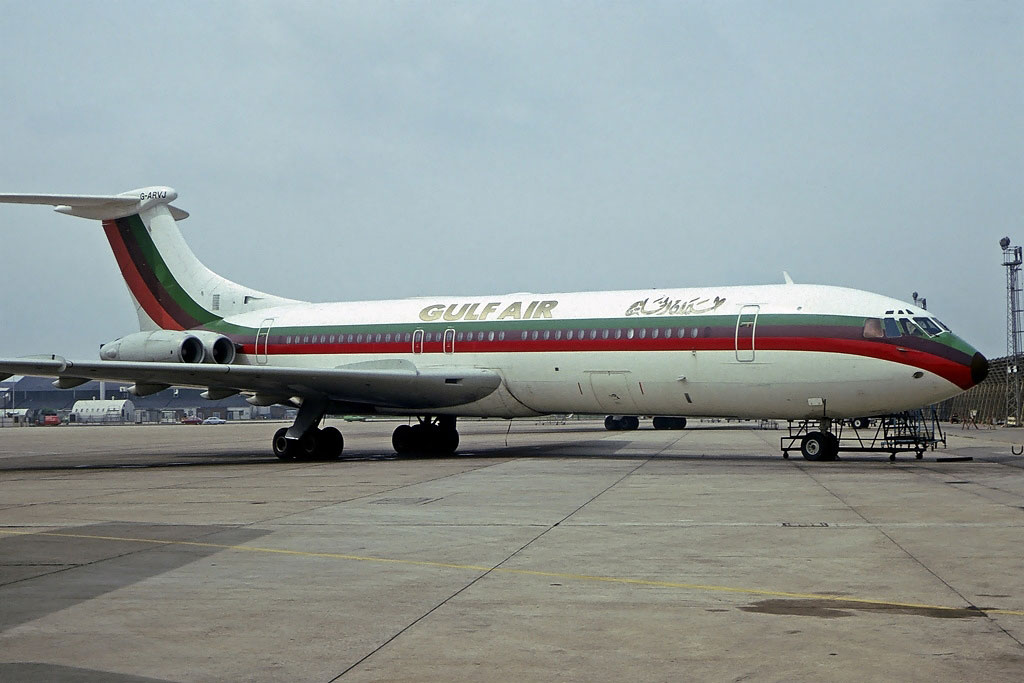
VC10 of Gulf Air (Steve Fitzgerald, distributed under a GFDL 1.2 Licence)
The first Super VC10 made its maiden flight on the 7 May 1964. The Super VC10 flight test programme was relatively short and during March and April 1965, five Super VC10s were delivered to BOAC. By the end of May 1969 BOAC had its full complement of 17 Super VC10s, G-ASGR being the last one to be delivered. The Super VC10 formally entered service with BOAC on the 1 April 1965, flying from London Airport (Heathrow) to New York and then on to San Francisco.

Standard VC10 G-ARVJ of BOAC on final approach into Heathrow (Richard Vandervord, distributed under a CC BY-SA 4.0 Licence
The merger of BOAC and BEA in April 1974, to form British Airways, signalled the end for the Standard VC10. The newly-arrived Boeing 747 began to take routes from the VC10. BOAC had eleven remaining Standard VC10s at the time of the merger. Five aircraft were initially leased and then sold to Gulf Air, one was sold to the UAE Government, and one was leased to the Qatar Government. Boeing purchased three aircraft as part-payment for the Boeing 747s, but did not put them to any use and in October 1976 scrapped them at Heathrow. One remaining Standard VC10 was retained by British Airways and used as back-up aircraft for the Super VC10 fleet until October 1979. The Super VC10s remained in service with British Airways until 1980/81. The final commercial flight was on the 29 March 1981.
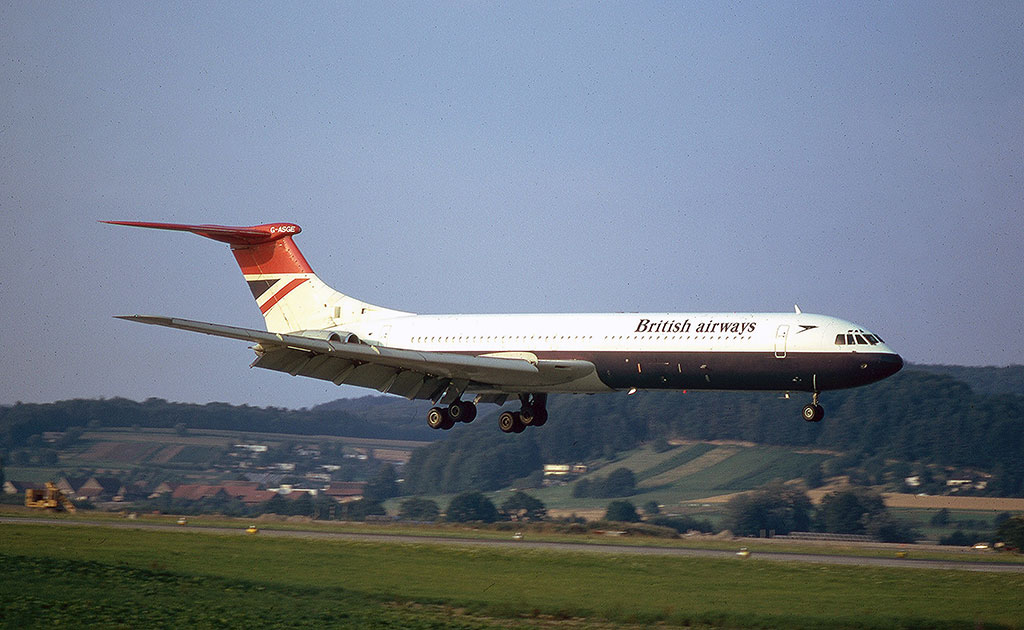
Super VC10 G-ASGE of British Airways about to land at Zurich Airport (clipperarctic, distributed under a CC BY-SA 2.0 Licence)
BOAC’s requirements for the VC10 to operate from short airfields, at high altitudes and in hot temperatures, constrained the development of the VC10 which restricted its worldwide appeal. Nevertheless, it was operated by a number of other airlines. The Standard VC10 was used by British United Airways/British Caledonian, Ghana Airways, Nigerian Airways, Middle East Airlines, Air Malawi, Air Ceylon and Gulf Air. Three VC10s were operated as VIP aircraft for the United Arab Emirates Government, the Royal Flight of Oman and the Qatar Amiri Flight. In addition to BOAC, the only other civilian user of the Super VC10 was East African Airways.
Royal Air Force VC10s
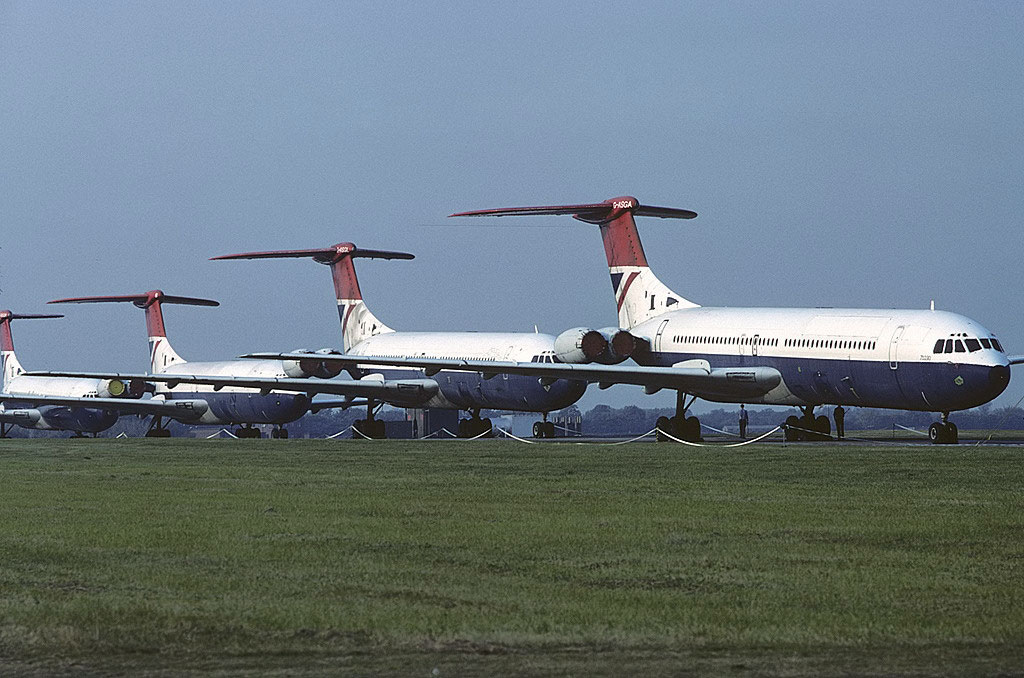
Former British Airways’ Super VC10s in storage at RAF Abingdon prior to conversion to K4 tankers or being broken up (Mike Freer, distributed under a GFDL 1.2 Licence)
The Royal Air Force acquired fourteen Standard VC10s (designated C Mk.1) which were used in transport, aero-medical evacuation and VIP roles. Five Standard VC10s were bought from Gulf Air and four Super VC10s from East African Airways for conversion into K.2 and K.3 tankers respectively. Fourteen of BA’s remaining Super VC10s were purchased by the RAF. Five aircraft were converted into K.4 tankers, and a number were broken up for spares.
A total of 54 VC10s were built, 33 Standard and 21 Super variants.
VC10 Technical Stats
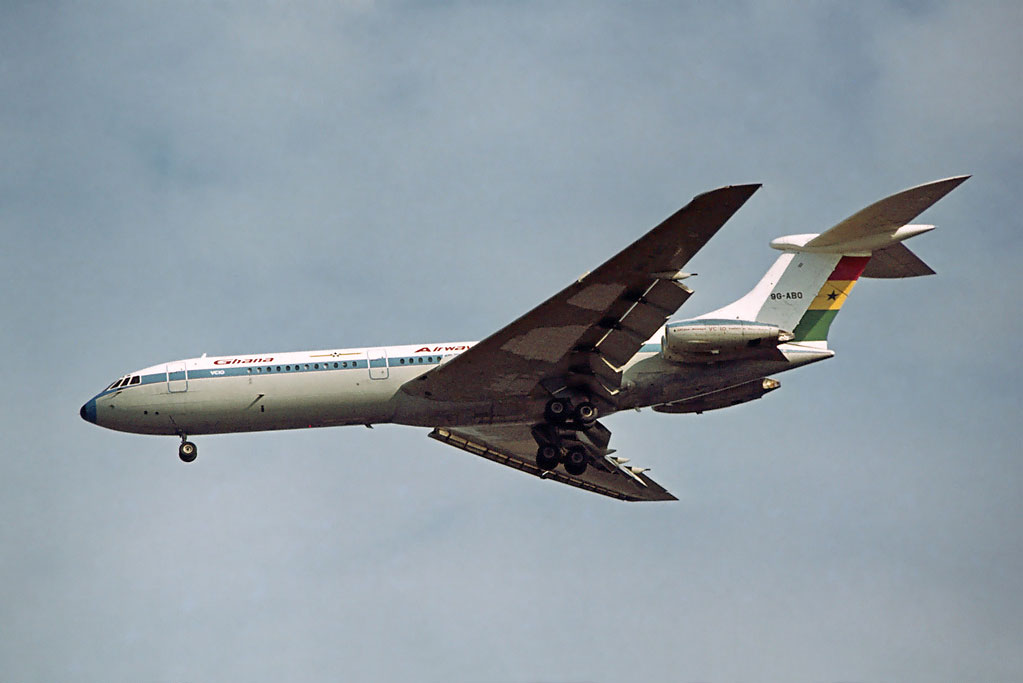
Standard VC10 9G-ABO of Ghana Airways on final approach into Heathrow (Steve Fitzgerald, distributed under a GFDL 1.2 Licence)
| Specification | Standard VC10 (Type 1101) | Super VC10 (Type 1151) |
| Length | 158ft 8in | 171ft 8in |
| Height | 39ft 6in | 39ft 6in |
| Wingspan | 146ft 2in | 146ft 2in |
| Wing area | 2,851ft2 | 2,932ft2 |
| Tailplane span | 43ft 10in | 43ft 10in |
| Tailplane area | 638ft2 | 638ft2 |
| Cabin length | 92ft 4in | 105ft 0in |
| Cabin width | 11ft 6in | 11ft 6in |
| Accommodation | 139 in two classes; Max. 151 in single class high density, 6 abreast | 151 in two classes; Max. 174 all economy, 6 abreast |
| Maximum payload | 40,420lb | 58,172lb |
| Basic operating weight empty | 146,980lb | 156,828lb |
| Max payload range (no reserves) | 4,380nm | 4,100nm |
| Maximum fuel range (no reserves) | 5,275nm | 6,195nm |
| Powerplants | 4 x Rolls-Royce Conway RCo.42 turbofans | 4 x Rolls-Royce Conway RCo.43 turbofans |
Flying Firsts
Discover more about the world’s commercial airliners in Flying Firsts.
This airliner reference guide covers all aircraft and variants from the 1930s to the present day, with histories, facts, statistics, dates and lots of colour photographs.


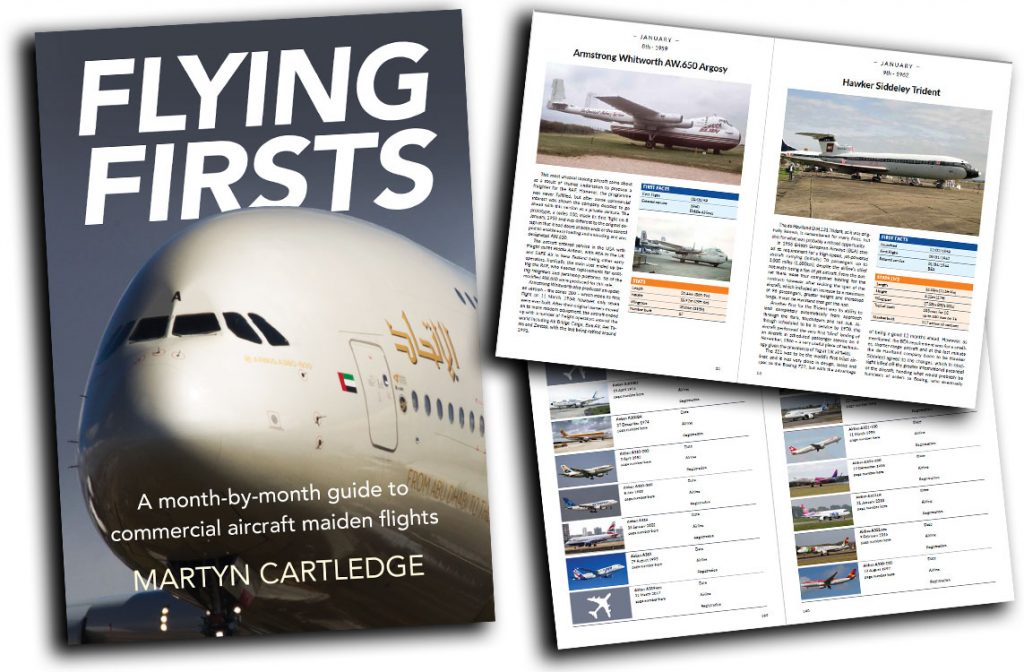



2 comments
What a beautiful aeroplane to have flown in, with BOAC and BUA, just loved its sereness. Sadly it was not a great commercial success, like so many British airliners. Fortunately I was able to have two jump seat trips in them as a bonus.
Miss that distinctive engine sound
Amazing that you got to fly in the cockpit Merv!